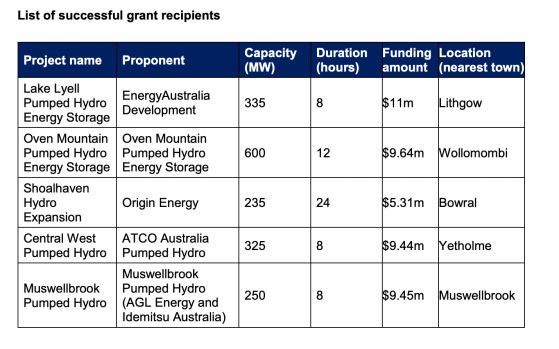Five NSW pumped hydro projects have received funding worth $45 million from the state government to help them get up and running.

The NSW Pumped Hydro Recoverable Grants program provides developers with funding to support pre-investment activities and cover up-front costs.
The grants are repaid to the government once a project reaches a financial close.
Renewable energy plans
The government says the program aims to establish a pipeline of up to 3 gigawatts of feasible pumped hydro projects that can make competitive bids for long-term energy service agreements for long duration storage under the Electricity Infrastructure Investment Safeguard.
According to the Climate Council, 1 GW is enough to power around 300,000 homes.
Energy minister Matt Kean says the five successful grant applicants announced last week, with a combined capacity of almost 1.75GW, received a total of $44.8 million for pre-investment, project feasibility and to develop strategic business cases.
Mr Kean said pumped hydro was a key component of the State’s renewable energy plans and had the potential to bring economic benefits to the regions.
If these pumped hydro projects proceed to construction, they are expected to create more than 2,300 jobs and attract $4.4 billion of private investment, which will help grow the economy and support the regions.
Energy minister Matt Kean
“NSW has the most ambitious renewable energy policy in the nation, which is needed to replace ageing coal fired power stations and build a clean energy future for NSW,” he said.
“If these pumped hydro projects proceed to construction, they are expected to create more than 2,300 jobs and attract $4.4 billion of private investment, which will help grow the economy and support the regions.”
That government has committed $97.5 million towards pumped hydro project as it moves towards its target of building at least 2GW of new long duration storage by 2030.
Water as a giant battery
Hydro pump storage uses water like a giant battery to store energy which can be quickly fed into the National Electricity Market when needed.
It involves multiple reservoirs of water – one at a high elevation, and one at a low elevation – and uses surplus renewable energy to pump water up from the lower reservoir to the upper reservoir during times of low demand.
When demand for power rises, the process is reversed, and water from the upper reservoir is released back into the lower reservoir through turbines that generate electricity, which is then sent to the grid for use in homes and businesses.
However, pumped hydro projects face long lead times with a lengthy and costly development that can take around eight years.
The project to receive the most funding – $11 million – is being developed by Energy Australia and proposes Lake Lyell near Lithgow for a pumped hydro operation.

The government says it is not proposing new on-river dams for hydro-electric generation but supports “sensible, private development of new off-river, closed-loop pumped hydro infrastructure.”
This means private operators can choose to construct their own dams – away from rivers – if they comply with the government’s framework.





Leave a Reply